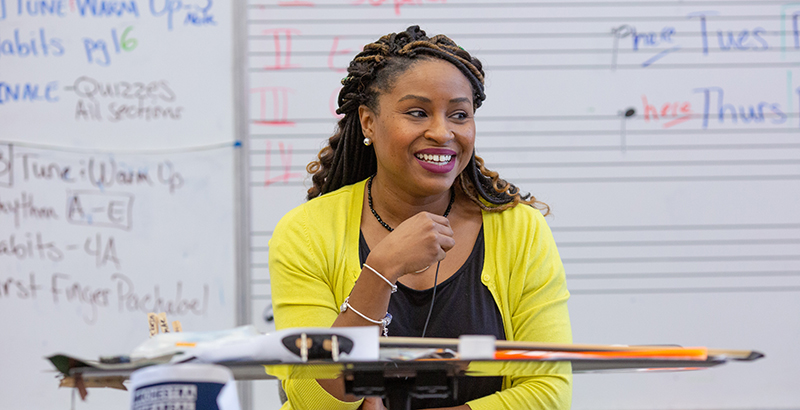Hostetter: NYS Will Need 180,000 Teachers in the Next Decade, Especially Educators of Color. 3 Ways to Draw More Candidates to This Great Profession

Get stories like these delivered straight to your inbox. Sign up for The 74 Newsletter
The nation is in dire need of a next generation of diverse, excellent teachers. In New York state, for example, 180,000 new teachers are needed over the next decade, and the majority should be teachers of color. Research suggests that students’ test scores, attendance and even suspension rates are positively affected by having a diverse faculty of teachers. Encouragingly, Secretary of Education Miguel Cardona and Gov. Kathy Hochul have put forward proposals recently to recruit more candidates to this great profession.
In my nearly 20 years of experience in education, working closely with hundreds of teachers and schools, I’ve seen the need for these kinds of reforms up close. As president of Relay Graduate School of Education, I’ve seen that recruiting and preparing talented, effective, diverse teachers is possible. We prepare close to 1,500 new teachers per year for New York’s public schools. Seventy percent of our graduate students are people of color — a crucial group of new teachers, mentors and role models for the state’s children, the majority of whom are kids of color. With some thoughtful additions, the approaches Hochul and Cardona put forth could not only increase the number of teachers entering the profession, but also address longstanding challenges to diversifying those leading the nation’s classrooms. To do this means focusing on three areas: support, cost and removal of barriers.
Support. Teaching residency programs, like those in medicine, provide new practitioners with hands-on training for one year, working with a mentor to develop the knowledge, skills and mindsets of great teachers. Residencies show promising results with respect to the diversity of the candidates they attract, the retention of those teachers in the profession and the learning outcomes of their students.
In New York City, for example, Ed Prep is a residency program providing paraprofessionals, teacher aides and parent coordinators with a pathway to become teachers. Nearly all graduates of this “grow your own” approach are people of color, and 100% are already committed education professionals in the communities in which they will ultimately serve as teachers.
New teachers, particularly educators of color joining a predominantly white profession, also need peer and mentor support. In partnership with the Georgia Power Foundation, Relay launched an affinity group for Black male teachers that is in its second enthusiastic year. Participants have called it a sacred space for bonding with others who share their experiences and tackling common challenges. In his research on Black male teacher candidates, Travis Bristol, assistant professor in the Graduate School of Education at the University of California, Berkeley has found that such affinity groups are invaluable for holding candid conversations, building community and solving problems. Also known as employee resource groups in the corporate world, such cohorts are associated with increased job retention and satisfaction.
Cost. Teachers should be paid more, which both Hochul’s plan and Cardona’s call to action recognize. But there are also other ways to ease teachers’ financial burdens — for example, by lowering or eliminating the cost of training to ensure they aren’t starting their career with unrealistic debt. Lowering the cost of entry can be achieved in many ways. The New York City Department of Education subsidizes participants’ tuition in teacher residency programs, as do many charter schools. Tennessee is fully funding tuition for its “grow your own” teacher prep programs, and Atlanta Public Schools is utilizing a grant to cover tuition for men of color who are currently special education paraprofessionals.
Beyond supporting the cost of schooling, districts can prioritize embedding their residency programs into their funding model for the long run. For example, Colonial School District in Delaware has worked with the paraprofessionals union to build a pathway to teaching that allows them to maintain their full salary and benefits. Previously, paraprofessionals who wanted to enter the residency program had to resign and take on a different position at lower pay.
Eliminate barriers. Finally, it is essential to remove illogical barriers that keep otherwise successful teacher candidates from entering the field. While high standards for teachers’ knowledge and skills must be upheld, there is evidence that the current gate-keeping systems don’t do this in a way that predicts student success in learning. Moving to multiple pathways to show content expertise, reducing emphasis on tests that don’t correlate with academic achievement (and disproportionately lock out teachers of color) and examining children’s experiences and outcomes with early-career teachers are all vast improvements.
Research and our own experience at Relay prove that there are promising ways to do this work and make an impact. Recruiting and retaining 180,000 teachers will take more than the three solutions I propose here, but they would be a good start. The country can’t afford to throw people into the classroom and hope for the best, bankrupt hardworking teachers or leave promising candidates out in the cold because of bureaucratic and invalid gateways. Prioritizing teachers’ needs can make schools places where they want to work. And approaching the work in this way can also help diversify the profession to better serve all students.
Dr. Mayme Hostetter is president of Relay Graduate School of Education.
Get stories like these delivered straight to your inbox. Sign up for The 74 Newsletter

;)